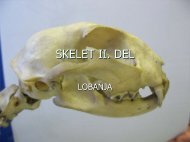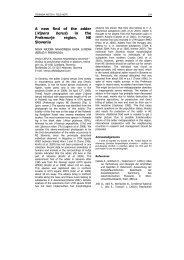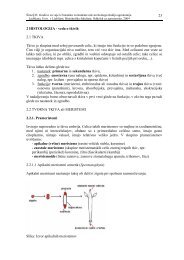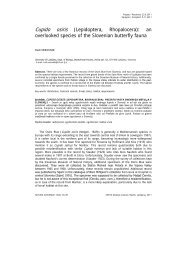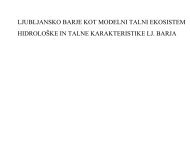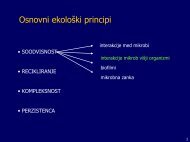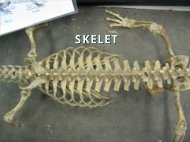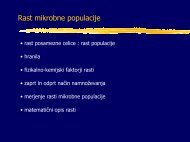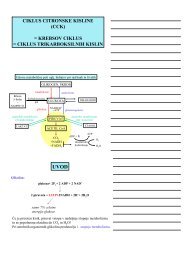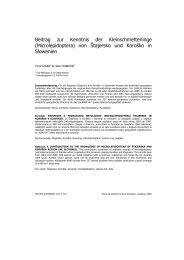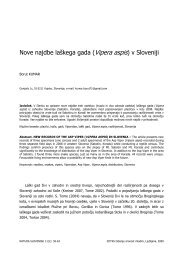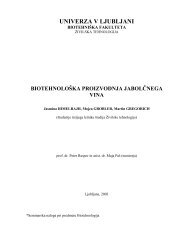Global diversity of leeches (Hirudinea) in ... - Univerza v Ljubljani
Global diversity of leeches (Hirudinea) in ... - Univerza v Ljubljani
Global diversity of leeches (Hirudinea) in ... - Univerza v Ljubljani
You also want an ePaper? Increase the reach of your titles
YUMPU automatically turns print PDFs into web optimized ePapers that Google loves.
136 Hydrobiologia (2008) 595:129–137<br />
sometimes even <strong>of</strong>fered for sale as genu<strong>in</strong>e medic<strong>in</strong>al<br />
<strong>leeches</strong>. Even some rhynchobdellids (Haementeria<br />
<strong>of</strong>fic<strong>in</strong>alis <strong>in</strong> Mexico, Placobdella costata <strong>in</strong> Krym)<br />
have been <strong>in</strong> medical use.<br />
The ‘‘medic<strong>in</strong>al leech’’ is protected and/or listed as<br />
endangered species <strong>in</strong> many European countries. It is<br />
not clear to what extent the alleged unfavorable<br />
conservation status is a consequence <strong>of</strong> past overharvest<strong>in</strong>g<br />
and how much <strong>of</strong> it can be contributed to<br />
more recent habitat destruction. Moreover, as long as<br />
the new taxonomic knowledge is not taken <strong>in</strong>to<br />
account, we will not even know which species we are<br />
struggl<strong>in</strong>g to preserve.<br />
Through centuries <strong>of</strong> exploitation and translocation<br />
the natural distribution <strong>of</strong> all Hirudo spp. was probably<br />
substantially affected by humans. More conspicuous,<br />
however, are transcont<strong>in</strong>ental <strong>in</strong>troductions, like the one<br />
<strong>of</strong> SE Asian Hirud<strong>in</strong>aria manillensis to the West Indies<br />
(Kutschera & Roth, 2006), probably also as a consequence<br />
<strong>of</strong> transport for medical purposes. Accidental<br />
transfers <strong>of</strong> <strong>leeches</strong> have resulted <strong>in</strong> several successful<br />
<strong>in</strong>vasions <strong>of</strong> new ranges, most noticeably by the<br />
mislead<strong>in</strong>gly named Neotropic glossiphoniid Helobdella<br />
europaea to Europe and Australia (e.g., Kutschera<br />
2004), or the salifid Barbronia weberi from Asia to<br />
Europe and Australia. Other non-native Helobdella spp.<br />
have been reported from Europe, and the Australian<br />
Barbronia arcana from Mexico (Oceguera-Figueroa<br />
et al., 2005). Although B. weberi has been characterized<br />
as <strong>in</strong>vasive (Govedich et al., 2003), the<br />
<strong>in</strong>vasiveness <strong>of</strong> most non-native leech species does<br />
not approach the aggressive nature <strong>of</strong> some <strong>in</strong>vasive<br />
crayfishes and fishes.<br />
Acknowledgments We thank Hasko Nesemann for k<strong>in</strong>dly<br />
provid<strong>in</strong>g his draw<strong>in</strong>gs, and Gregor Bračko for his help with<br />
copy<strong>in</strong>g out some literature data. This work was <strong>in</strong> part<br />
supported by the Slovenian Research Agency.<br />
References<br />
Apakupakul, K., M. E. Siddall & E. M. Burreson, 1999. Higher<br />
level relationships <strong>of</strong> <strong>leeches</strong> (Annelida: Clitellata: Euhirud<strong>in</strong>ea)<br />
based on morphology and gene sequences.<br />
Molecular Phylogenetics and Evolution 12: 350–359.<br />
Bielecki, A., 1997. Fish <strong>leeches</strong> <strong>of</strong> Poland <strong>in</strong> relation to the<br />
Palearctic piscicol<strong>in</strong>es (<strong>Hirud<strong>in</strong>ea</strong>: Piscicolidae: Piscicol<strong>in</strong>ae).<br />
Genus 8: 223–375.<br />
Borda, E. & M. E. Siddall, 2004. Arhynchobdellida (Annelida:<br />
Oligochaeta: Hirud<strong>in</strong>ida): phylogenetic relationships and<br />
123<br />
evolution. Molecular Phylogenetics and Evolution 30:<br />
213–225.<br />
Govedich, F. R., B. A. Ba<strong>in</strong>, M. Burd & R. W. Davies, 2003.<br />
Reproductive biology <strong>of</strong> the <strong>in</strong>vasive Asian freshwater<br />
leech Barbronia weberi (Blanchard, 1897). Hydrobiologia<br />
510: 125–129.<br />
Govedich, F. R., D. W. Bl<strong>in</strong>n, R. H. Hevly & P. S. Keim, 1999.<br />
Cryptic radiation <strong>in</strong> erpobdellid <strong>leeches</strong> <strong>in</strong> xeric landscapes:<br />
a molecular analysis <strong>of</strong> population differentiation.<br />
Canadian Journal <strong>of</strong> Zoology 77: 52–57.<br />
Hard<strong>in</strong>g W. A. & J. P. Moore, 1927. <strong>Hirud<strong>in</strong>ea</strong>. In Shipley, E.<br />
(ed.), The Fauna <strong>of</strong> British India, <strong>in</strong>clud<strong>in</strong>g Ceylon and<br />
Burma. London.<br />
Klemm, D. J., 1972. Freshwater <strong>leeches</strong> (Annelida: <strong>Hirud<strong>in</strong>ea</strong>)<br />
<strong>of</strong> North America. Biota <strong>of</strong> freshwater ecosystems identification<br />
manual no. 8. Water Pollution Control Research<br />
Series. U.S. Environmental Protection Agency, Wash<strong>in</strong>gton,<br />
D.C.<br />
Kutschera, U., 2004. The freshwater leech Helobdella europaea<br />
(<strong>Hirud<strong>in</strong>ea</strong>: Glossiphoniidae): an <strong>in</strong>vasive species<br />
from South America? Lauterbornia 52: 153–162.<br />
Kutschera, U. & M. Roth, 2006. Notes on the ecology <strong>of</strong> the<br />
Asian medic<strong>in</strong>al leech Hirud<strong>in</strong>aria manillensis (<strong>Hirud<strong>in</strong>ea</strong>:<br />
Hirud<strong>in</strong>idae). Lauterbornia 56: 9–13.<br />
L<strong>in</strong>naeus, C., 1789. Systema Naturae. Vermes.<br />
Luk<strong>in</strong>, E. I., 1976. Pijavki. Tom I. Pijavki presnyh i solonovatyh<br />
vodoemov, Izdatel’stvo ‘‘Nauka’’, Len<strong>in</strong>grad.<br />
Mart<strong>in</strong>, P., 2001. On the orig<strong>in</strong> <strong>of</strong> the <strong>Hirud<strong>in</strong>ea</strong> and the demise <strong>of</strong><br />
the Oligochaeta. Proceed<strong>in</strong>gs <strong>of</strong> the Royal Society <strong>of</strong> London<br />
Series B––Biological Sciences 268: 1089–1098.<br />
Moore, J. P., 1898. The <strong>leeches</strong> <strong>of</strong> the U. S. National Museum.<br />
Proceed<strong>in</strong>gs US National Museum 21(1160): 543–563.<br />
Moqu<strong>in</strong>-Tandon, A., 1846. Monographie de la famille des<br />
Hirud<strong>in</strong>ees. Paris.<br />
Nesemann, H. & E. Neubert, 1999. Annelida: Clitellata:<br />
Branchiobdellida, Acanthobdellea, <strong>Hirud<strong>in</strong>ea</strong>. In: Süßwasserfauna<br />
von Mitteleuropa, 6/2. Spektrum<br />
Akademischer Verlag, Heidelberg, Berl<strong>in</strong>.<br />
Oceguera-Figueroa, A., V. León-Règagnon & M. E. Siddall,<br />
2005. Phylogeny and revision <strong>of</strong> the Erpobdelliformes<br />
(Annelida, Arhynchobdellida) from Mexico based on<br />
nuclear and mitochondrial gene sequences. Revista Mexicana<br />
de Biodiversidad 76: 191–198.<br />
Pawlowski, L. K., 1948. Contributions á la systématique des<br />
sangsues dú genre Erpobdella de Bla<strong>in</strong>ville. Acta zoologica<br />
et oecologica Universitatis Lodziensis, sect. III 8:<br />
1–55.<br />
Pilcher, H., 2004. Medic<strong>in</strong>al <strong>leeches</strong>: stuck on you. Nature 432:<br />
10–11.<br />
R<strong>in</strong>guelet, R. A., 1980. Biogeografia de los hirud<strong>in</strong>eos de<br />
America del Sur y de Mesoamerica. Obra del Centenario<br />
del Museo de La Plata 6: 1–27.<br />
Sawyer, R. T., 1986. Leech biology and behaviour. Clarendon<br />
Press, Oxford.<br />
Siddall, M. E. & E. M. Burreson, 1998. Phylogeny <strong>of</strong> <strong>leeches</strong><br />
(<strong>Hirud<strong>in</strong>ea</strong>) based on mitochondrial cytochrome c oxidase<br />
subunit I. Molecular Phylogenetics and Evolution 9:<br />
156–162.<br />
Siddall, M. E., 2002. Phylogeny <strong>of</strong> the leech family Erpobdellidae<br />
(<strong>Hirud<strong>in</strong>ea</strong>: Oligochaeta). Inveretbrate Systematics<br />
16: 1–6.



